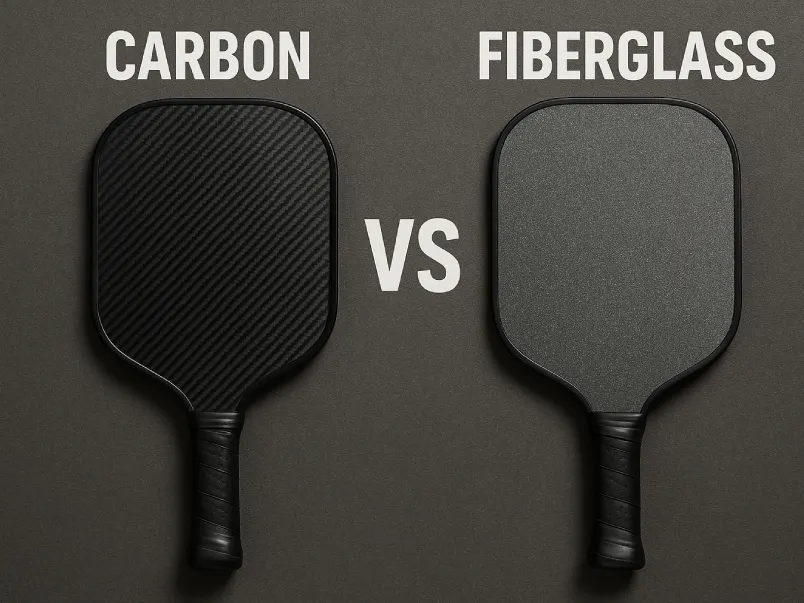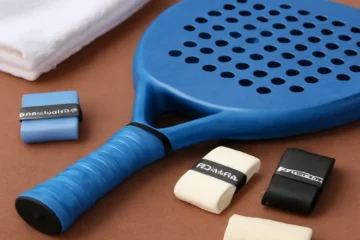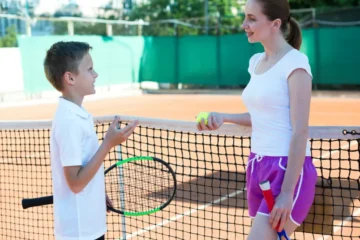Choosing the right racket can feel overwhelming. With so many options available, it’s easy to get lost in technical jargon like “carbon fiber” and “fiberglass.” If you’ve ever found yourself staring at the endless choices in a sports store or browsing online, you’re not alone. This dilemma often boils down to a core question: is a high-performance carbon racket worth the investment, or does the reliable fiberglass racket offer better value?
In this article, we’ll break down the differences between carbon and fiberglass rackets—looking at material composition, performance, feel, and price—to help you make an informed decision that best suits your game and your budget.
Part 1: Understanding the Materials: What Are You Actually Swinging?
Before we dive into performance comparisons, it’s essential to understand the materials that make up these rackets. Let’s explore what exactly you’re swinging when you pick up a carbon or fiberglass racket.
1.1 Fiberglass: The Flexible and Forgiving Workhorse
Fiberglass is a composite material made of glass fibers embedded in a plastic resin. This material is known for its flexibility and shock absorption, which makes it an excellent option for players who prioritize comfort over power or precision. Fiberglass rackets are typically a bit heavier to compensate for their flexibility, but they offer an impressive level of forgiveness, especially for beginners or players who are still refining their techniques.
Key Properties:
- Flexibility: Fiberglass is more flexible than carbon, which results in less power transfer but greater comfort, as it helps to absorb the impact from the ball.
- Shock Absorption: Its high level of shock absorption makes fiberglass a popular choice for players who experience arm fatigue or joint pain.
- Durability: While fiberglass is durable, it can lose its shape over time, especially if subjected to frequent hard impacts.
Analogy: If we had to compare fiberglass to something, think of it like a reliable, shock-absorbing SUV. It may not have the speed or precision of a race car, but it gets the job done comfortably and dependably.
1.2 Carbon Fiber: The Stiff and Powerful Elite Performer
Carbon fiber is composed of thin, crystalline filaments of carbon, tightly woven together to create a material that is both incredibly stiff and lightweight. Carbon fiber rackets are designed for performance, offering explosive power, precision, and ultimate control. With an exceptional stiffness-to-weight ratio, carbon fiber provides maximum energy transfer, making it ideal for players who need the highest levels of responsiveness.
Key Properties:
- Stiffness: Carbon fiber’s stiffness provides excellent power transfer, making it perfect for advanced players who need a racket that can generate maximum force.
- Lightweight: Due to its strong, lightweight nature, carbon fiber allows for a faster swing speed, contributing to more agility on the court.
- Durability: Carbon fiber rackets are highly resistant to deformation and last longer than fiberglass rackets, even under intense use.
Analogy: Carbon fiber can be compared to a Formula 1 race car. It’s lightweight, incredibly responsive, and built for peak performance—perfect for those who want to take their game to the next level.
Part 2: Head-to-Head Comparison: Breaking Down the Key Factors
To help you decide which material is the best fit for your needs, let’s compare fiberglass and carbon fiber rackets across several important factors:
| Feature | Fiberglass Rackets | Carbon Fiber Rackets | Winner For… |
|---|---|---|---|
| Power & Stiffness | Flexible, absorbs energy; less power transfer. | Very stiff, efficient energy transfer; more power. | Power: Carbon |
| Control & Precision | Less feedback and precision due to flex. | Excellent feedback and pinpoint accuracy. | Control: Carbon |
| Shock Absorption & Comfort | Excellent; reduces vibration and arm fatigue. | Stiff, transmits more vibration; can be harsh on the arm. | Comfort: Fiberglass |
| Durability | Durable but can warp or lose shape over time. | Extremely durable and resistant to deformation. | Durability: Carbon |
| Weight | Generally heavier to achieve stability. | Can be incredibly light without sacrificing stability. | Lightweight: Carbon |
| Price & Value | Very affordable; excellent value for beginners. | Significantly more expensive; an investment. | Budget: Fiberglass |
Power & Stiffness
Fiberglass rackets tend to be more flexible, which makes them absorb more energy, but that also means they don’t transfer power as efficiently as carbon fiber. Carbon fiber, on the other hand, is very stiff, allowing it to efficiently transfer energy, resulting in greater power.
Winner: Carbon, for superior power.
Control & Precision
Fiberglass, with its flexibility, offers less feedback and control, which can be a downside for players looking for pinpoint precision. Carbon fiber’s stiffness provides excellent feedback, allowing for precise control and more accurate shots.
Winner: Carbon, for better control and precision.
Shock Absorption & Comfort
Fiberglass shines in this category, offering excellent shock absorption and comfort. Its flexible nature helps reduce vibration, making it an ideal choice for players who need to reduce arm fatigue or manage injuries. Carbon fiber rackets, while high-performing, transmit more vibration, which can be harsh on the arm during extended play.
Winner: Fiberglass, for superior comfort.
Durability
Carbon fiber is incredibly durable and resistant to warping or losing its shape, even under high-impact conditions. Fiberglass is also durable but can lose its form over time, especially if subjected to repeated hard hits.
Winner: Carbon, for better durability.
Weight
Carbon fiber rackets are generally lighter than fiberglass ones, providing better maneuverability without sacrificing stability. The lightweight nature of carbon allows for faster swings and more agility on the court.
Winner: Carbon, for a lighter, more maneuverable racket.
Price & Value
Fiberglass rackets are significantly more affordable than carbon fiber options, making them an excellent choice for beginners or recreational players. Carbon fiber rackets, while offering superior performance, come with a higher price tag, making them a more significant investment.
Winner: Fiberglass, for budget-conscious players.
Part 3: Which Racket is Right for Your Player Profile?
Choosing the right racket depends on your skill level, playing style, and budget. Here’s a breakdown of which material is best for different types of players:
3.1 The Beginner / Recreational Player
Recommended Material: Fiberglass or a fiberglass-composite blend.
Why: For beginners, a forgiving racket is essential. Fiberglass rackets offer a comfortable playing experience by reducing vibrations and providing ample shock absorption. This flexibility helps mitigate mistakes during the learning process. Additionally, the affordability of fiberglass makes it a great option for those just starting out.
3.2 The Intermediate / Club Player
Recommended Material: A Carbon Composite or a mid-range full-carbon racket.
Why: Intermediate players need a balance between power and control. A carbon composite racket, which blends carbon with other materials like fiberglass, offers the responsiveness and power of carbon without the steep price of a high-end full-carbon racket. This is the sweet spot for performance and price.
3.3 The Advanced / Competitive Player
Recommended Material: High-Modulus Carbon Fiber.
Why: Advanced players who have developed their technique can fully harness the benefits of carbon fiber. With its stiffness, power, and precision, a high-modulus carbon fiber racket provides the responsiveness needed to compete at higher levels. The price is justified for players who are serious about performance and competition.
3.4 The Player with Arm/Shoulder Issues
Recommended Material: Fiberglass or a carbon racket with vibration-dampening technology.
Why: If you experience arm or shoulder pain, the flexibility and shock-absorbing qualities of fiberglass are crucial. However, some carbon rackets are designed with vibration-dampening systems, which can reduce the harsh impacts while still providing the performance benefits of carbon.
Part 4: Other Considerations Before You Buy
The Importance of Balance and Shape
Material is just one aspect of a racket’s performance. The shape of the frame and the balance (whether the racket is head-heavy, head-light, or evenly balanced) also play a significant role in how a racket feels and performs. For example, a tear-shaped carbon racket will behave very differently from a round-shaped fiberglass racket.
Feel is Subjective
The best racket for you is ultimately the one that feels right in your hands. Some players prefer a flexible racket for comfort, while others prefer the stiff, responsive feel of carbon. If possible, try demoing different rackets before making your decision.
Watch for Blends
Many rackets are not made from 100% carbon or fiberglass. “Carbon 100%” means the entire frame is carbon fiber, while “Carbon Composite” typically blends carbon with fiberglass or other materials to offer a balanced performance. These blends can offer a great middle ground in terms of cost and performance.
Conclusion: Making Your Final Choice
Choosing between a fiberglass and a carbon racket ultimately comes down to what matters most to you—comfort and value versus performance and precision.
Final Recommendation:
- Choose Fiberglass if you are a beginner, on a tight budget, value comfort above all, or play recreationally.
- Choose Carbon if you are a serious or competitive player, have developed solid technique, and are willing to invest in superior power and control.
In either case, understanding the differences between these two materials is a huge step toward finding the perfect racket for your game. Once you’ve selected the right racket, you’ll be able to enjoy the game even more.
FAQs:
1. What’s the difference between carbon and fiberglass rackets?
Carbon fiber rackets are stiff, lightweight, and provide greater power and control, making them ideal for advanced or competitive players. In contrast, fiberglass rackets are more flexible and offer better shock absorption, making them a great choice for beginners and recreational players who prioritize comfort and affordability.
2. Which racket material is best for beginners?
Fiberglass is the best choice for beginners. It is more forgiving on mishits, reduces arm fatigue with its shock-absorbing properties, and is more affordable, making it perfect for those just starting out.
3. Are carbon fiber rackets worth the investment?
Yes, if you are an intermediate or advanced player, a carbon fiber racket is worth the investment. It provides superior power, control, and durability, and can improve your performance significantly, especially if you have developed the technique to handle its stiffness.
4. Can fiberglass rackets be used for competitive play?
While fiberglass rackets are more commonly used by beginners and recreational players, some intermediate players may still use them if they value comfort over power. However, carbon fiber rackets are generally better suited for competitive play due to their precision and power.
5. Do carbon fiber rackets cause more arm fatigue?
Carbon fiber rackets tend to transmit more vibration, which can be harsher on the arm, potentially causing more fatigue. However, many carbon fiber rackets are designed with vibration-dampening technologies to mitigate this issue. Players with arm or shoulder concerns may prefer fiberglass or specialized carbon rackets with these features.
6. How much should I expect to spend on a carbon vs. fiberglass racket?
Fiberglass rackets are more affordable, often ideal for beginners or recreational players on a budget. Carbon fiber rackets, being high-performance, are significantly more expensive but can be seen as an investment for serious or competitive players.
7. Can I try rackets before buying?
Yes, many sports stores and online retailers offer demo programs or trial periods, allowing you to test different rackets before making your final purchase. This can help you get a feel for the racket’s performance and comfort.




